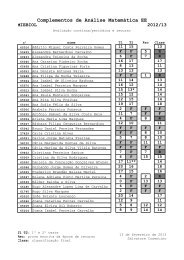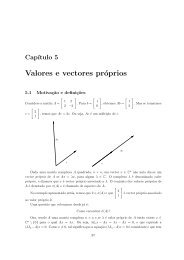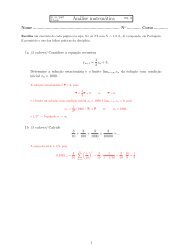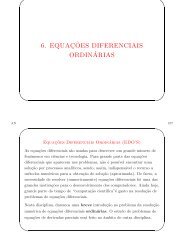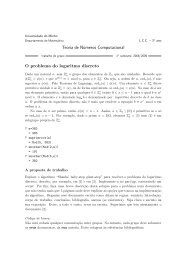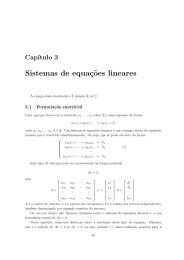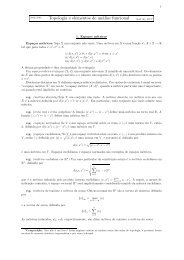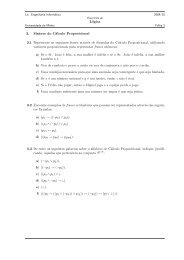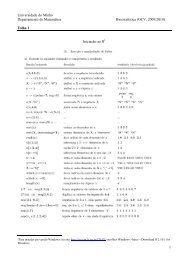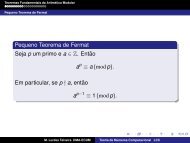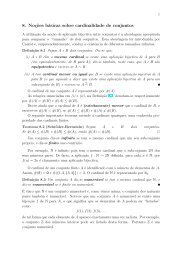My title - Departamento de Matemática da Universidade do Minho
My title - Departamento de Matemática da Universidade do Minho
My title - Departamento de Matemática da Universidade do Minho
Create successful ePaper yourself
Turn your PDF publications into a flip-book with our unique Google optimized e-Paper software.
16 ERGODICITY AND CONVERGENCE OF TIME MEANS 102<br />
16 Ergodicity and convergence of time means<br />
16.1 Ergodicity<br />
Ergodic maps. Let f : X → X be an en<strong>do</strong>morphism of the measurable space (X, E). The<br />
invariant probability measure µ is said ergodic if any of the following equivalent conditions is<br />
satisfied:<br />
i) for any observable ϕ ∈ L 1 (µ), the time average<br />
1<br />
ϕ (x) = lim<br />
n→∞ n + 1<br />
n∑<br />
ϕ ( f k (x) )<br />
exists and is equal to the mean value ∫ ϕdµ for µ-almost any x ∈ X,<br />
X<br />
ii) any invariant event A ∈ E has probability µ (A) = 0 or 1, namely the invariant σ-algebra<br />
E f is equal to the trivial σ-algebra N generated by events of zero measure,<br />
iii) any invariant (measurable) observable ϕ is constant µ-a.e.<br />
If this happens, one also says that f is an ergodic en<strong>do</strong>morphism of the probability space<br />
(X, E, µ).<br />
Condition i) is the physical meaning of ergodicity, as it says that “time averages are almost<br />
everywhere constant and equal to space averages”. In particular, taking ϕ equal to the characteristic<br />
function of any event A, almost any trajectory spend in A a fraction of time asymptotically<br />
proportional to µ (A), as dreamed by Boltzmann in his ergodic hypothesis.<br />
Condition ii) is what one usually check in or<strong>de</strong>r to prove ergodicity of a probability measure.<br />
To see that i) ⇒ ii), let A be an invariant event, and ϕ its characteristic function. Invariance of A<br />
implies that ϕ is invariant, hence that ϕ = ϕ. There follows fom i) that µ (A) = ∫ ϕdµ = ϕ (x)<br />
X<br />
for some x ∈ X, hence that µ (A) = 0 or 1, the only values of characteristic functions.<br />
Conditions ii) and iii) are clearly equivalent, since any invariant event <strong>de</strong>fines an invariant<br />
function (its characteristic function), and conversly level sets of invariant functions are invariant<br />
events.<br />
Finally, in or<strong>de</strong>r to show that iii) ⇒ i), let ϕ ∈ L 1 (µ) be an integrable observable. According<br />
to the Birkhoff-Khinchin ergodic theorem, the time average ϕ (x) exists for µ-almost any x ∈ X<br />
and ∫ X ϕdµ = ∫ ϕdµ. Since ϕ is invariant mod 0, by iii) it is constant with probability one. This<br />
X<br />
implies that ϕ (x) = ∫ ϕdµ for µ-almost any x ∈ X.<br />
X<br />
k=0<br />
Warning. Ergodic dynamical systems exist, and some are listed below. On the other si<strong>de</strong>, to<br />
show that a physically interesting system is ergodic turns out to be extremely difficult, and very<br />
few examples are known. The most famous are some “billards”, systems of hard spheres insi<strong>de</strong> a<br />
billard table interacting via elastic collisions, studied by Yakov Sinai in the sixties...<br />
Ergodic measures as extremal measures. We already saw that the space Prob f of invariant<br />
probability measure is a convex and closed subset of the compact space Prob. Here, we observe<br />
that ergodic measures are the “in<strong>de</strong>composable” elements of this set.<br />
Proposition. Ergodic invariant measures are the extremals of Prob f . Namely, an invariant<br />
measure µ is ergodic iff it cannot be written as<br />
µ = tµ 1 + (1 − t) µ 0<br />
where t ∈ ]0, 1[ and µ 0 and µ 1 are distinct invariant measures.<br />
proof. First, observe that if ν is an invariant measure which is absolutely continuous w.r.t. the<br />
ergodic measure µ, then ν = µ. In<strong>de</strong>ed, one easily verifies that the Ra<strong>do</strong>n-Nykodim <strong>de</strong>rivative<br />
ρ = dν/dµ is an invariant function, and ergodicity of µ implies that it is constant and equal to one<br />
µ-a.e. Now, let µ be an ergodic measure, and assume that µ = tµ 1 + (1 − t) µ 0 for some t ∈ ]0, 1[.<br />
Since both µ 0 and µ 1 are absolutely continuous w.r.t. µ, they coinci<strong>de</strong> with µ, hence, are not



